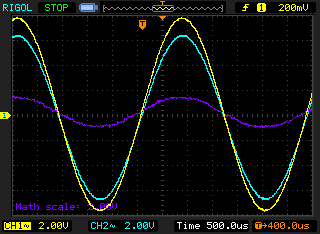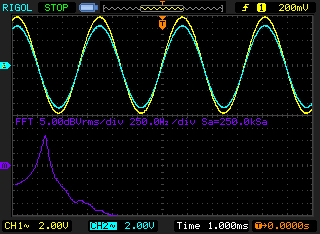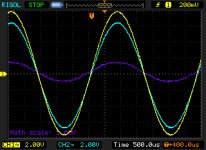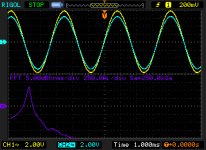I m openning this thread to describe the little things I know (or think I know) so that we can discuss it a bit further.
First of all, since the cartridge signal is probably too low (especially on MC ones) I m measuring the signal on the phono output (which also gives us RIAAed signal).
We really need a record that includes frequency tracks on both stereo channels (together and independently) (need your proposal here... already have the HiFi news one but it only has separate noise tracks)
It s also nice to have a 2 channel oscilloscope so that we can see both signals at once and use the math/fft functions of the scope.
On the first screenshot, I have the two signals on top of each other. The difference is almost 1v, which is rather substantial. Probably due to bad azimouth (unfortunately the SL1200 MK2 shell does not offer azimouth adjustment... I should get a Jelco or something)
The purple line show the difference between the two channels (math A-B)

Unfortunately the HiFi news record does not have separate channel tracks with frequencies. Only noise which makes it difficult to get a measure of the crosstalk (or am I missing something?).
The second screenshot shows FFT of the left channel. We see some small spikes on the right of the 300Hz signal, probably showing some distortion? I need your help here on how to better understand what we can see in an FFT graph.

Measuring the frequency is very easy using the relevant measure options of the scope. For me both channels had a small deviation from the 300Hz of the disk (around 320Hz on both channels) which points rather to a deviation on how the disk was cut, or a deviation in the phono RIAA.
I really need to learn how to work on triggers and acquiring technics so that I manage to see the frequency responses using the ferquency sweep tracks.
Waiting for your comments, additions, advice, curses, whatever...
First of all, since the cartridge signal is probably too low (especially on MC ones) I m measuring the signal on the phono output (which also gives us RIAAed signal).
We really need a record that includes frequency tracks on both stereo channels (together and independently) (need your proposal here... already have the HiFi news one but it only has separate noise tracks)
It s also nice to have a 2 channel oscilloscope so that we can see both signals at once and use the math/fft functions of the scope.
On the first screenshot, I have the two signals on top of each other. The difference is almost 1v, which is rather substantial. Probably due to bad azimouth (unfortunately the SL1200 MK2 shell does not offer azimouth adjustment... I should get a Jelco or something)
The purple line show the difference between the two channels (math A-B)
Unfortunately the HiFi news record does not have separate channel tracks with frequencies. Only noise which makes it difficult to get a measure of the crosstalk (or am I missing something?).
The second screenshot shows FFT of the left channel. We see some small spikes on the right of the 300Hz signal, probably showing some distortion? I need your help here on how to better understand what we can see in an FFT graph.
Measuring the frequency is very easy using the relevant measure options of the scope. For me both channels had a small deviation from the 300Hz of the disk (around 320Hz on both channels) which points rather to a deviation on how the disk was cut, or a deviation in the phono RIAA.
I really need to learn how to work on triggers and acquiring technics so that I manage to see the frequency responses using the ferquency sweep tracks.
Waiting for your comments, additions, advice, curses, whatever...
Attachments
Measuring the frequency is very easy using the relevant measure options of the scope. For me both channels had a small deviation from the 300Hz of the disk (around 320Hz on both channels) which points rather to a deviation on how the disk was cut, or a deviation in the phono RIAA.
The phono RIAA filter does not change the frequency of the signal. It only changes the level of the signal.
Your observed difference is either the result of of the disk being cut at that frequency and/or your turntable running fast. I assume that it's both of those: the frequency on the record could easily be 315Hz and the remaining difference could be the contribution of your turntable.
I have always found it curious that, despite all of the audiophile turntable setup tools, jigs, and gizmos, we are STILL waiting for a proper test LP. I think I remember one that was put out by Bruel&Kjaer in the 70s that did have tones in stereo and each channel, but I have never seen one in the flesh. This will be step one in making alignment work well with an oscilloscope.
The old Cardas Frequency Sweep and Burn-In Record No. 1 had test tones in stereo and in each channel. You could try and find a used one. The new one Cardas Frequency Sweep and Burn-In Record No. 2 no longer has them [weird].
Analogue Productions has more recently produced what they call "The Ultimate Analogue Test LP" and that one has stereo tones plus right and left and some other useful signals. It is currently available, but it isn't cheap. I bought it anyway.
Analogue Productions has more recently produced what they call "The Ultimate Analogue Test LP" and that one has stereo tones plus right and left and some other useful signals. It is currently available, but it isn't cheap. I bought it anyway.
Interesting thread, a lot of to learn, suscribed!!!!
me too.
could the 1v come from anti skate?
i guess I'm asking if the A.S. was off would it show up like that.....or how would it look?
also what if the R&L side of your phono pre isn't matched? like right side 20db of gain and left is 21, or whatever.
should you adjust for that at the cart? will that mess up lps?
Last edited:
Tone arm damping.
One Japanese audio magazine had an article on tone arm damping with frequency plots of the low end of the freq scale. Plotted to show the effect of different damping schemes. I had the articles for many years but can't find them now though some other material is still there.
Should be possible to do similar tests nowadys with the storage scopes I guess.
The Denon test discs should have a low freq sweep for this test.
Does anyone have a set up that can run such tests ?
One Japanese audio magazine had an article on tone arm damping with frequency plots of the low end of the freq scale. Plotted to show the effect of different damping schemes. I had the articles for many years but can't find them now though some other material is still there.
Should be possible to do similar tests nowadys with the storage scopes I guess.
The Denon test discs should have a low freq sweep for this test.
Does anyone have a set up that can run such tests ?
Azimuth and anti-skating do NOT significantly affect channel balance, so if you see an imbalance its cause has to be found elsewhere. More often than not it is shoddy cartridge build.
Azimuth DOES affect channel separation, and one of the easiest ways for quantifying this is with the HFN test disc noise tracks, which you record, import into a computer, and subject to spectral analysis averaged over some 10 seconds.
Please have a look at my reports at TNT, for instance
Lyra Dorian phono cartridge (English)
Most modern test records are NOT calibrated and their recorded signal quality is very suspect. AFAIK there is no modern record with an accurate frequency sweep or series of spot tones (I tried them all). The HFN mono noise track is marginally useful, but veers off in the final octave (use it at 45 rpm with RIAA-warping to look further into the treble).
There are no modern records with the correct test tones to assess VTA.
Making a really good test record is an expensive task, and the resulting record will only remain good for a few plays. The majors do not consider there being a market for such things. Compared to the old Denon, JVC, CBS, ... records modern offerings like HFN, Cardas, AP are amateuristic.
The Feickert record may be an exception, but it comes only with the Adjust+ software making it a tad expensive.
Azimuth DOES affect channel separation, and one of the easiest ways for quantifying this is with the HFN test disc noise tracks, which you record, import into a computer, and subject to spectral analysis averaged over some 10 seconds.
Please have a look at my reports at TNT, for instance
Lyra Dorian phono cartridge (English)
Most modern test records are NOT calibrated and their recorded signal quality is very suspect. AFAIK there is no modern record with an accurate frequency sweep or series of spot tones (I tried them all). The HFN mono noise track is marginally useful, but veers off in the final octave (use it at 45 rpm with RIAA-warping to look further into the treble).
There are no modern records with the correct test tones to assess VTA.
Making a really good test record is an expensive task, and the resulting record will only remain good for a few plays. The majors do not consider there being a market for such things. Compared to the old Denon, JVC, CBS, ... records modern offerings like HFN, Cardas, AP are amateuristic.
The Feickert record may be an exception, but it comes only with the Adjust+ software making it a tad expensive.
Nice writeup on the Dorian Werner.
Gave me some nice insights on how to work with the scope.
I saw you are using the HFN record's pink noise tracks for the crosstalk. I will try it again, although last time I got really weird results...
Either my cartridge is foobar or I am doing something really wrong because I m a noob with the scope.
Just a clarification on how to measure the residue. We use a one channel (left or right) pink noise and measure the curve on the other one right?
About the -3db compensation for pink noise attenuation per octave, I dont think it would be necessary for our needs here, since we are just trying to get things equal on both channels.
I guess we can still get some rough estimates on the frequency response and harmonic distortion though, assuming a -3db per octave on the frequency response and the harmonics fft.
Gave me some nice insights on how to work with the scope.
I saw you are using the HFN record's pink noise tracks for the crosstalk. I will try it again, although last time I got really weird results...
Either my cartridge is foobar or I am doing something really wrong because I m a noob with the scope.
Just a clarification on how to measure the residue. We use a one channel (left or right) pink noise and measure the curve on the other one right?
About the -3db compensation for pink noise attenuation per octave, I dont think it would be necessary for our needs here, since we are just trying to get things equal on both channels.
I guess we can still get some rough estimates on the frequency response and harmonic distortion though, assuming a -3db per octave on the frequency response and the harmonics fft.
I don't know if it's the "best" procedure, but I used an old Shure trackability record to adjust antiskate. I look for mistracking to commence in both channels at the same time. It's very easy to see on a scope- I haven't tried using a fast spectrum analyzer, but I'd expect that to work as well. This probably isn't a great procedure if you change cartridges a lot, since you probably damage the record a bit each time, but for someone like me who finds a happy-sounding cartridge and sticks with it for years, it seems to work.
If you have a record with a tone that has an increasing amplitude (like Werner uses), then you'll see the distortion start on one channel or the other. Adjust antiskate until that distortion starts at the same point. The Shure record isn't quite as good as that (it presents different bands at discrete increasing levels), but it saves my more expensive records.
- Status
- This old topic is closed. If you want to reopen this topic, contact a moderator using the "Report Post" button.
- Home
- Source & Line
- Analogue Source
- Cartridge alignment with Oscilloscope

